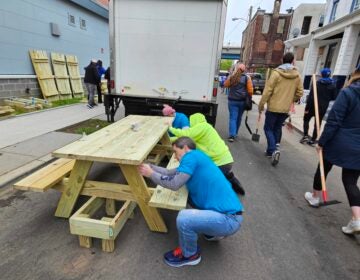ACES Museum honors minority veterans
Sgt. Stephen E. Sherman walked along Germantown Avenue with two pieces of paper clipped to his clothes – they both asked for money. He wasn’t begging, he was raising funds for veterans groups.
One organization supports homeless veterans and the other is mounting an effort to overcome legal barriers to award Doris “Dorie” Miller the Medal of Honor posthumously for his actions during Pearl Harbor.
Sherman was in Germantown on a recent sunny Saturday for the ACES Museum’s official day of honor for minority veterans. Set before Memorial Day by a week or so, this ceremony is meant both to honor the sacrifices and accomplishments of the country’s non-white veterans, and to educate about some of the important history that has impacted them and many others.
The Germantown museum presented 10 minority veterans with medals at 3 p.m. at Center in the Park. Before that, it gave the almost 30 present a bit of a history lesson.
Sherman, who came to the event from California, spoke about how he has worked for more than 60 years to get Miller the medal of honor. During Pearl Harbor, Miller shot down four Japanese war planes. It was a time, Sherman said, when black men weren’t supposed to fight.
His organization, the Dorie Miller Foundation, is devoted to the cause of honoring Miller’s heroism and valor.
Also part of this trip into history was Chief Three Feathers, who grew up in a Native American community. She wore white buffalo jewelry and feathers in her earrings, which are used for special occasions. She described how the Navajo saved many lives carrying military codes during war time by translating the codes into the Navajo language so enemy forces couldn’t understand.
That kind of devotion to a nation that did not allow them the right to vote until 1924, and often persecuted them is remarkable, Three Feathers said.
“Here are the first people, and yet they weren’t allowed to vote,” she said.
Following the talks, Dr. A.V. Hankins, chairwoman and executive director for ACES’ board of directors, lead the crowd across the street to the museum. Everyone went inside, where Hankins lead each person down the stairs to an old basement.
Hankins briefly talked about an African mask and paintings before entering the next room. A wood-burning stove from the 1800s was first noticeable in a room where Hankins said slaves were once kept in a group.
They went from work to the room with stone walls and dirt floors, and nowhere else. The museum doesn’t know how many people were kept in the room, she said.
“Most slave sites were known,” she said. “[These were] slaves that weren’t allowed out.”
As Hankins spoke, Belinda Butler paid close attention. She hadn’t planned on attending the event at all.
She was at the park with her two daughters, Nicole, 10, and Angel, 8, when she saw the crowd and asked what was going on. She decided to stay and was surprised to find so much important history living on, right under her nose in the unassuming ACES building at the corner of Germantown and Price Street.
The family stayed for lunch. Nicole and Angel were most interested in the jump the broom ceremony, a tradition from Africa that is part of a wedding.
WHYY is your source for fact-based, in-depth journalism and information. As a nonprofit organization, we rely on financial support from readers like you. Please give today.




